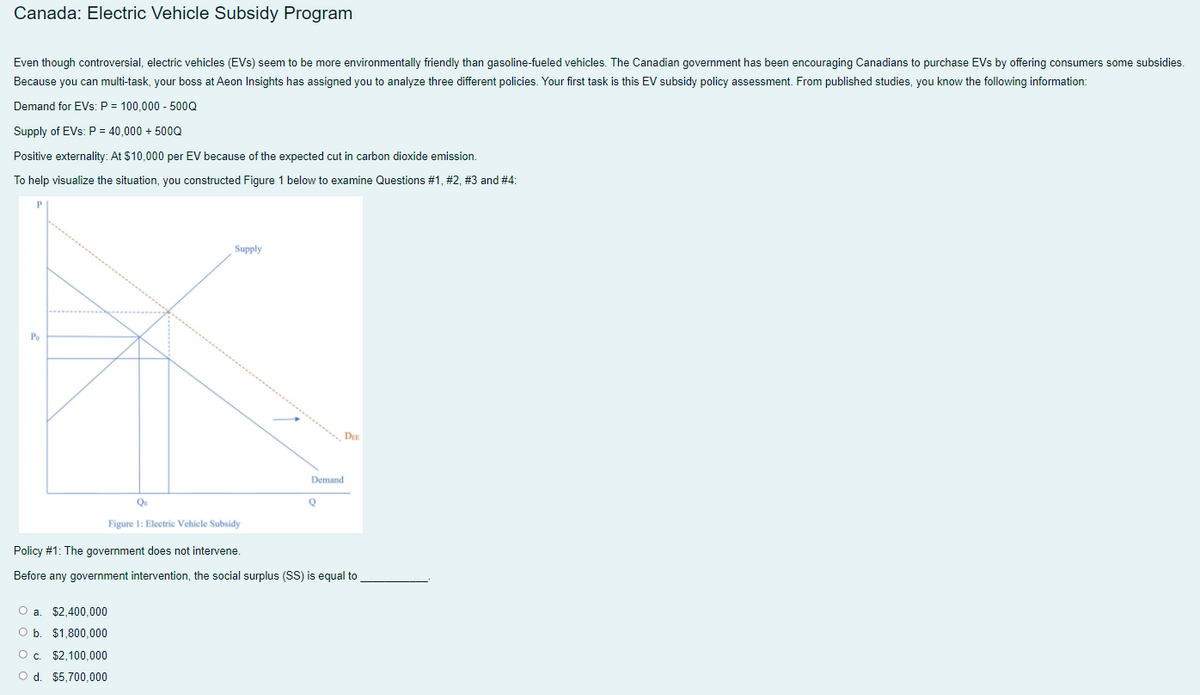Canada: Electric Vehicle Subsidy Program Even though controversial, electric vehicles (EVs) seem to be more environmentally friendly than gasoline-fueled vehicles. The Canadian government has been encouraging Canadians to purchase EVs by offering consumers some subsidies. Because you can multi-task, your boss at Aeon Insights has assigned you to analyze three different policies. Your first task is this EV subsidy policy assessment. From published studies, you know the following information: Demand for EVs: P = 100,000 - 500Q Supply of EVs: P = 40,000 + 500Q Positive externality: At $10,000 per EV because of the expected cut in carbon dioxide emission. To help visualize the situation, you constructed Figure 1 below to examine Questions #1, #2, #3 and #4: Supply Po Du Demand Figure I: Electric Vehicle Subsidy Policy #1: The government does not intervene. Before any government intervention, the social surplus (SS) is equal to O a. $2.400.000 O b $1,800,000 O. $2,100,000 Od. $5.700,.000
Canada: Electric Vehicle Subsidy Program Even though controversial, electric vehicles (EVs) seem to be more environmentally friendly than gasoline-fueled vehicles. The Canadian government has been encouraging Canadians to purchase EVs by offering consumers some subsidies. Because you can multi-task, your boss at Aeon Insights has assigned you to analyze three different policies. Your first task is this EV subsidy policy assessment. From published studies, you know the following information: Demand for EVs: P = 100,000 - 500Q Supply of EVs: P = 40,000 + 500Q Positive externality: At $10,000 per EV because of the expected cut in carbon dioxide emission. To help visualize the situation, you constructed Figure 1 below to examine Questions #1, #2, #3 and #4: Supply Po Du Demand Figure I: Electric Vehicle Subsidy Policy #1: The government does not intervene. Before any government intervention, the social surplus (SS) is equal to O a. $2.400.000 O b $1,800,000 O. $2,100,000 Od. $5.700,.000
Managerial Economics: Applications, Strategies and Tactics (MindTap Course List)
14th Edition
ISBN:9781305506381
Author:James R. McGuigan, R. Charles Moyer, Frederick H.deB. Harris
Publisher:James R. McGuigan, R. Charles Moyer, Frederick H.deB. Harris
Chapter4: Estimating Demand
Section: Chapter Questions
Problem 7E
Related questions
Question
Solve correctly both the subparts

Transcribed Image Text:Canada: Electric Vehicle Subsidy Program
Even though controversial, electric vehicles (EVs) seem to be more environmentally friendly than gasoline-fueled vehicles. The Canadian government has been encouraging Canadians to purchase EVs by offering consumers some subsidies.
Because you can multi-task, your boss at Aeon Insights has assigned you to analyze three different policies. Your first task is this EV subsidy policy assessment. From published studies, you know the following information:
Demand for EVs: P = 100,000 - 500Q
Supply of EVs: P = 40,000 + 500Q
Positive externality: At $10,000 per EV because of the expected cut in carbon dioxide emission.
To help visualize the situation, you constructed Figure 1 below to examine Questions #1, #2, #3 and #4:
Supply
Demand
Qu
Q
Figure 1: Electric Vehicle Subsidy
Policy #1: The government does not intervene.
Before any government intervention, the social surplus (SS) is equal to
O a. $2,400,000
$1,800,000
Oc. $2,100,000
O d. $5,700,000

Transcribed Image Text:Policy #2: Consumption Subsidy at $10,000 per EV
The Canadian government can offer consumers of EV a $10,000 rebate/refund per unit. The SS is equal to
O a. $2,450,000
O b. $3,850,000
Oc.
$3,150,000
O d. $4,550,000
Expert Solution
This question has been solved!
Explore an expertly crafted, step-by-step solution for a thorough understanding of key concepts.
Step by step
Solved in 4 steps with 2 images

Recommended textbooks for you

Managerial Economics: Applications, Strategies an…
Economics
ISBN:
9781305506381
Author:
James R. McGuigan, R. Charles Moyer, Frederick H.deB. Harris
Publisher:
Cengage Learning

Managerial Economics: Applications, Strategies an…
Economics
ISBN:
9781305506381
Author:
James R. McGuigan, R. Charles Moyer, Frederick H.deB. Harris
Publisher:
Cengage Learning